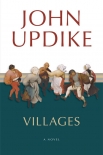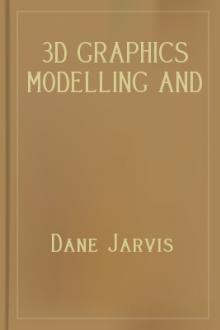Villages, John Updike [brene brown rising strong .TXT] 📗

- Author: John Updike
Book online «Villages, John Updike [brene brown rising strong .TXT] 📗». Author John Updike
The crammed two pews contain every life-stage from terminal disablement through alcoholic corpulence, deep-lined sun damage, gym-hardened muscularity, spa-enhanced svelteness, teen-age bloom and sudden growth spurt, adolescent squirminess and giggliness, childish pudginess suffocatingly wrapped in boredom, toddler stupefaction and imminent tantrum, on down to the recently baptized infant sleeping in milky bliss on her young mother’s lap. The Wainthrops form a synoptic image of life’s tragic progress, but it is an image overlaid with graciousness, mannerliness, and tribal consciousness of a value greater than the sum of its parts. Not for the rich the scattered wandering, the flight from the ill-equipped nuclear family into America’s wasteland of tawdry entertainments, of shopping-mall parking lots as large as lakes and seedy roadside bars advertising karaoke on Wednesday nights, of deserted downtowns and razed forests, of roving job to job and mate to mate, amid such meagre electronic distractions as heist movies featuring car wrecks and fireballs and television comedies that reflect as in a fuzzy, fizzing mirror the awkward comedy of our desperate daily improvisations beyond the ordering principles of church, village, and family hierarchy. Only the rich—and not all of them, for some turn rebellious and others topple through self-neglect into lower castes—can afford the old structures that carry us from cradle to grave, well-fed, well-clothed, and well-respected. To Owen, an only child most intensely himself when engrossed in coded conversation with the coolly burning face of a cathode-ray tube, the interlocking clans of Haskells Crossing are paradigms of community, a web spun stronger than as of steel. The women are mostly of Anglo-Saxon blood—fair, with forthright warrior jaws—and the men so big-boned they look a touch sheepish in their tailored business suits. However, the web has snared, here and there, brides of Asian or Latin blood, and grooms recruited from swarthier races—the Jewish lawyer, the Italo-American bond salesman—to keep the gene pool fresh.
After church, while Julia, drawing upon her years of experience, is giving a lengthy piece of advice to the rector, Owen finds himself standing on the fringe of the Wainthrop cluster, and especially close to the young mother of the sleeping infant, who is now weakly, crankily awake and being jostled on her mother’s twitching hip. The woman is more statuesque than she had appeared in the crammed pew. She has the glossy long free-falling hair of ’sixties flower children and Nordic features slightly larger than lifesize. Her feet are long and strong, in high heels held in place by white thongs wrapping several times around her ankles; her blond hair sets off unplucked dark eyebrows and pouting broad lips lipsticked a luminescent coral tint. She has jumped the season by donning (the Sunday having begun sunny though it is now turning cloudy and cooler) a minidress of broad horizontal stripes the colors of half the rainbow, its fit everywhere tight, as if her body might overpower her clothes at any moment. As Owen furtively watches, other Wainthrops come up to her to admire the new baby and to receive and give the deft little air-kisses of the rich. He has to look away; his gaze could become an indiscretion; here is the kind of raw big beauty, radiant as a naked mother’s breadth in the eyes of her speechless son, that bids his male heart, old as he has become, to worship, to drop his body at her knees in pure pagan adoration, on this specifically Christian terrain of Haskells Crossing.
Who wants to be next? Phyllis had asked, there on the Slades’ sunporch, and it was some time before Owen could have answered. He was more and more on the road, as E-O Data struggled to hold its place in an industry ever more tipped to the West Coast. In 1968 he had travelled to a computer conference in San Francisco to see a former radar technician named Douglas Engelbart demonstrate a hand-held invention called an “X-Y position indicator for a monitor system,” soon to be called a “mouse.” In a ninety-minute lecture Engelbart showed, via a computer twenty-five miles away, how commands could be issued, with no text command, to a monitor screen divided into windows. Owen realized that the hardware of the future was here, and back at E-O he experimented with integrating the X-Y principle with the light pen that was still the tool for computer-aided design. But in the absence of pixel-specific pinpointing, dependent upon sufficient computer capacity to store and resolve the line-scan CRT, he was still stuck, for his second redesign of DigitEyes (DigitEyes 2.2), with the light pen, placed directly on the monitor screen to communicate an X-Y address. Enlargement or rotation of a sketched vector image still required a variety of numerical line commands. The speed and precision of the graphics were dazzling, and enlargements and reductions to the 103 order were possible, but the methods were still tied to an alphanumeric machine-language with its cumbersome manual.
It was in 1974, at the Palo Alto Research Center, or PARC, belonging to the Xerox Corporation, a sponsorship that tipped the research toward mass-marketable products rather than military or corporate problem-solving, when Owen saw his first true graphical user interface, on the PARC Alto. His heart sank; the interface, with its mouse-manipulated icons and its schematic imitation of an ordinary desktop, relegated all technical instructions to the hidden program. The operator simply moved an on-screen indicator with his mouse and dropped and dragged icons or blocks of highlighted text. The day of the command-line interface was





Comments (0)